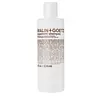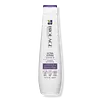What's inside
What's inside
 Key Ingredients
Key Ingredients

No key ingredients
 Benefits
Benefits

 Concerns
Concerns

 Ingredients Side-by-side
Ingredients Side-by-side

Water
Skin ConditioningSodium Cocoyl Isethionate
CleansingCocamidopropyl Hydroxysultaine
CleansingDisodium Laureth Sulfosuccinate
CleansingCocamide Mipa
EmulsifyingDecyl Glucoside
CleansingSodium Chloride
MaskingMentha Arvensis Leaf Oil
MaskingLimonene
PerfumingGlycerin
HumectantSodium Benzoate
MaskingCoconut Acid
CleansingCitric Acid
BufferingSodium Methyl Cocoyl Taurate
CleansingGuar Hydroxypropyltrimonium Chloride
Skin ConditioningSodium Isethionate
CleansingPotassium Sorbate
PreservativeSodium Phytate
Isopropanolamine
BufferingSodium PCA
HumectantBenzoic Acid
MaskingSodium Lactate
BufferingArginine
MaskingAspartic Acid
MaskingPCA
HumectantGlycine
BufferingAlanine
MaskingSerine
MaskingValine
MaskingIsoleucine
Skin ConditioningProline
Skin ConditioningThreonine
Histidine
HumectantPhenylalanine
MaskingWater, Sodium Cocoyl Isethionate, Cocamidopropyl Hydroxysultaine, Disodium Laureth Sulfosuccinate, Cocamide Mipa, Decyl Glucoside, Sodium Chloride, Mentha Arvensis Leaf Oil, Limonene, Glycerin, Sodium Benzoate, Coconut Acid, Citric Acid, Sodium Methyl Cocoyl Taurate, Guar Hydroxypropyltrimonium Chloride, Sodium Isethionate, Potassium Sorbate, Sodium Phytate, Isopropanolamine, Sodium PCA, Benzoic Acid, Sodium Lactate, Arginine, Aspartic Acid, PCA, Glycine, Alanine, Serine, Valine, Isoleucine, Proline, Threonine, Histidine, Phenylalanine
Water
Skin ConditioningSodium Laureth Sulfate
CleansingCoco-Betaine
CleansingGlycol Distearate
EmollientSodium Chloride
MaskingCocamide Mea
EmulsifyingParfum
MaskingSodium Benzoate
MaskingHexylene Glycol
EmulsifyingGuar Hydroxypropyltrimonium Chloride
Skin ConditioningSalicylic Acid
MaskingCarbomer
Emulsion StabilisingLimonene
PerfumingHexyl Cinnamal
PerfumingCoumarin
PerfumingLinalool
PerfumingButylphenyl Methylpropional
PerfumingBenzyl Alcohol
PerfumingAloe Barbadensis Leaf Juice
Skin ConditioningPrunus Armeniaca Kernel Oil
MaskingTheobroma Grandiflorum Seed Butter
Skin ConditioningHydroxycitronellal
PerfumingAmyl Cinnamal
PerfumingSodium Hydroxide
BufferingCitric Acid
BufferingWater, Sodium Laureth Sulfate, Coco-Betaine, Glycol Distearate, Sodium Chloride, Cocamide Mea, Parfum, Sodium Benzoate, Hexylene Glycol, Guar Hydroxypropyltrimonium Chloride, Salicylic Acid, Carbomer, Limonene, Hexyl Cinnamal, Coumarin, Linalool, Butylphenyl Methylpropional, Benzyl Alcohol, Aloe Barbadensis Leaf Juice, Prunus Armeniaca Kernel Oil, Theobroma Grandiflorum Seed Butter, Hydroxycitronellal, Amyl Cinnamal, Sodium Hydroxide, Citric Acid
Ingredients Explained
These ingredients are found in both products.
Ingredients higher up in an ingredient list are typically present in a larger amount.
Citric Acid is an alpha hydroxy acid (AHA) naturally found in citrus fruits like oranges, lemons, and limes.
Like other AHAs, citric acid can exfoliate skin by breaking down the bonds that hold dead skin cells together. This helps reveal smoother and brighter skin underneath.
However, this exfoliating effect only happens at high concentrations (20%) which can be hard to find in cosmetic products.
Due to this, citric acid is usually included in small amounts as a pH adjuster. This helps keep products slightly more acidic and compatible with skin's natural pH.
In skincare formulas, citric acid can:
While it can provide some skin benefits, research shows lactic acid and glycolic acid are generally more effective and less irritating exfoliants.
Most citric acid used in skincare today is made by fermenting sugars (usually from molasses). This synthetic version is identical to the natural citrus form but easier to stabilize and use in formulations.
Read more about some other popular AHA's here:
Learn more about Citric AcidThis ingredient is derived from guar gum.
It is a conditioning ingredient, meaning it helps soften skin and hair.
Limonene is a fragrance that adds scent and taste to a formulation.
It's found in the peel oil of citrus fruits and other plants such as lavender and eucalyptus. The scent of limonene is generally described as "sweet citrus".
Limonene acts as an antioxidant, meaning it helps neutralize free radicals.
When exposed to air, oxidized limonene may sensitize the skin. Because of this, limonene is often avoided by people with sensitive skin.
The term 'fragrance' is not regulated in many countries. In many cases, it is up to the brand to define this term. For instance, many brands choose to label themselves as "fragrance-free" because they are not using synthetic fragrances. However, their products may still contain ingredients such as essential oils that are considered a fragrance.
Learn more about LimoneneSodium Benzoate is a preservative. It's used in both cosmetic and food products to inhibit the growth of mold and bacteria. It is typically produced synthetically.
Both the US FDA and EU Health Committee have approved the use of sodium benzoate. In the US, levels of 0.1% (of the total product) are allowed.
Sodium benzoate works as a preservative by inhibiting the growth of bacteria inside of cells. It prevents the cell from fermenting a type of sugar using an enzyme called phosphofructokinase.
It is the salt of benzoic acid. Foods containing sodium benzoate include soda, salad dressings, condiments, fruit juices, wines, and snack foods.
Studies for using ascorbic acid and sodium benzoate in cosmetics are lacking, especially in skincare routines with multiple steps.
We always recommend speaking with a professional, such as a dermatologist, if you have any concerns.
Learn more about Sodium BenzoateChances are, you eat sodium chloride every day. Sodium Chloride is also known as table salt.
This ingredient has many purposes in skincare: thickener, emulsifier, and exfoliator.
You'll most likely find this ingredient in cleansers where it is used to create a gel-like texture. As an emulsifier, it also prevents ingredients from separating.
There is much debate on whether this ingredient is comedogenic. The short answer - comedogenic ratings don't tell the whole story. Learn more about comegodenic ratings here.
The concensus about this ingredient causing acne seems to be divided. Research is needed to understand if this ingredient does cause acne.
Scrubs may use salt as the primary exfoliating ingredient.
Learn more about Sodium ChlorideWater. It's the most common cosmetic ingredient of all. You'll usually see it at the top of ingredient lists, meaning that it makes up the largest part of the product.
So why is it so popular? Water most often acts as a solvent - this means that it helps dissolve other ingredients into the formulation.
You'll also recognize water as that liquid we all need to stay alive. If you see this, drink a glass of water. Stay hydrated!
Learn more about Water